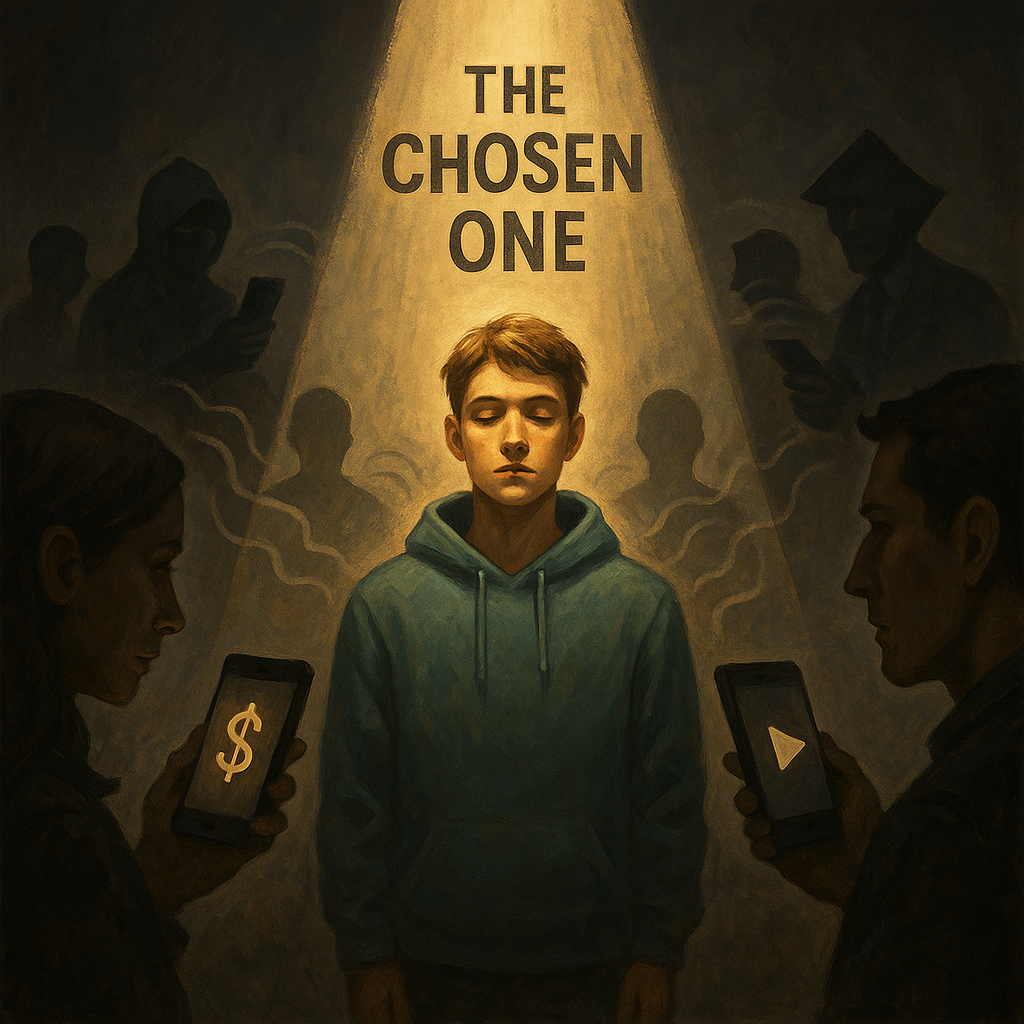“Black Mirror” is not a si-fi movie anymore. The darkness from some people (psychopaths in power) inner world is mirrored in this real world of ours. The effects are devastating, are criminal. The system and it’s methods are criminal. The world is captive, victim of an organized crime. The obedience is normalized, the mafia style is the way to “succeed” or even to survive (for most of the unaware participants in this). The excuse of being paid for a “dirty” job (a crime) is being normalized. It’s standard, it’s in a book of surviving in this world wide prison. I will describe some methods and effects in a series of articles on this blog.
The Chosen One trend
Here’s a concise breakdown of what’s happening with the “Chosen One” trend on TikTok (and beyond), how it’s driven by platform incentives and conspiracy-style narratives, its real-world impacts on unsuspecting individuals, and why it matters.
In short: TikTok’s Creator Program rewards attention-grabbing content, so some creators cast random or spiritual-leaning people as “Chosen Ones” with supernatural gifts or deep insights. Audiences latch on, boosting views—and creators monetize through affiliate links, merch, and sponsorships. Meanwhile, the subjects themselves are often gaslighted: any pushback is spun as proof they’re being “controlled,” reinforcing the narrative and keeping the views (and ad dollars) rolling in. This mirrors the broader “Targeted Individuals” conspiracy ecosystem—where ordinary people are portrayed as victims of hidden cabals—which thrives on social-media opacity and platform-user power imbalances. The result? Epistemic injustice, harassment, and real psychological harm for those labeled “Chosen.” Below we unpack each piece of this puzzle.
Origins and Motivations
Platform Incentives
TikTok’s Creator Program launched in 2021 lets popular creators earn directly from views and in-app gifts, encouraging ever-more sensational content—which conspiratorial posts often provide. A recent longitudinal study of 1.5 million US TikTok videos found that conspiratorial content, while a small fraction (~0.1%), tends to spike around new Creator Program features, suggesting monetary incentives drive conspiracy proliferation arXiv.
Cultural Roots
The “Chosen One” trope draws on millennia of religious and mythic narratives—heroes anointed to restore order—but on TikTok it’s repurposed: anyone with a quirky idea or spiritual bent can be elevated into a messianic figure. This taps into New Age and “targeted individuals” subcultures that believe special people are surveilled by shadowy groups.
Mechanics of the Trend
Labeling and Gaslighting
Creators spot someone with an unusual belief or talent and declare them a “Chosen One,” then frame any denial as evidence they’re “under mind control.” This is classic gaslighting: dismissing someone’s reality, then accusing them of being deceived if they push back. Platforms themselves reinforce this dynamic through opaque moderation, often contradicting users’ direct experiences—a phenomenon scholars now call “platform gaslighting”.
Viral Lifecycle
- Discovery: A video claims “You are the Chosen One” to random passers-by or spiritual seekers.
- Proof Clips: Montage of the subject’s past statements or life events, retroactively framed as prophetic.
- Call to Action: Viewers urged to duet or stitch with their own “Chosen One” moments.
- Monetization Link: Affiliate course, merch drop, or donation link in the bio.
Monetization Strategies
Creator Program & Brand Deals
Evidence shows conspiratorial creators saw a bump in their payouts after enrolling in TikTok’s bonus schemes—so they doubled down on “Chosen One” narratives to stay in the payout tiers.
Merch, Courses & Affiliate Links
Across dozens of accounts, you’ll find links to:
- “Awaken Your Inner Chosen One” e-books
- Branded crystals and talismans
- Paid webinars on resisting “mind control”
All designed to monetize the subject’s “awakening” while the subjects themselves rarely see a cut
Social and Psychological Impact
Epistemic Injustice
When platforms dismiss genuine complaints (“Your video was fine,” “No policy violation”), individuals doubt their own experiences—classic epistemic injustice, where victims’ voices are sidelined to protect a platform’s image.
Mental-Health Risks
Amnesty International warned that TikTok’s recommendation engine can push vulnerable viewers into harmful “rabbit holes” in under 20 minutes, exacerbating anxiety and paranoia—especially alarming when overlaid with “Chosen One” conspiracies.
Case Studies and Examples
- “Targeted Individuals You Have Abilities”: A recent viral clip telling viewers “Chosen ones, they fear your gifts”—the bio links to a $97 “spiritual awakening” course
- “Why Did I Become A Targeted Individual”: Uses religious language (“child of the Most High”) to frame a user’s intuition as proof of cosmic surveillance
- “Highly Spiritual People Targeted Individuals”: Montage of everyday activities reinterpreted as part of a “higher assignment”
Ethical and Regulatory Considerations
Content Moderation Challenges
Academic toolkits for fighting TikTok conspiracies note that platform policies lag behind evolving narrative tactics, making enforcement reactive rather than preventive.
Policy Proposals
Experts recommend:
- Transparency Reports on how “Targeted” content is surfaced.
- User Appeals with human review for alleged policy violations.
- Digital Literacy Campaigns teaching users about gaslighting and monetization tactics.
These steps aim to rebalance power between platforms, creators, and vulnerable individuals.
Bottom Line: The “Chosen One” trend isn’t innocent fun—it’s a monetized conspiracy tactic built on gaslighting and platform opacity. As it spreads, we’re likely to see more real-world harm unless platforms, regulators, and users get smarter about how these narratives are crafted and amplified.


